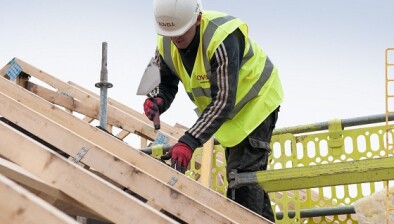Housing leads construction revival as output makes modest rebound
 Construction output appears to have experienced a rebound last month with business activity rising at its strongest rate since June, according to new figures.
Construction output appears to have experienced a rebound last month with business activity rising at its strongest rate since June, according to new figures.
Latest returns for the Markit/CIPS UK Construction Purchasing Managers’ Index survey also indicated that new orders and employment numbers increased in November more than they had done in the last five months.
However, the improvement in construction growth was largely confined to residential work. Civil engineering is now experiencing its longest period of decline since the first half of 2013.
Adjusted for seasonal influences, the IHS Markit/CIPS UK construction purchasing managers’ index (PMI) picked up from 50.8 in October to 53.1 in November. The latest reading was the highest for five months and above the 50.0 no-change value for the second month running.
House building projects were again the primary growth engine for construction activity. Survey respondents suggested that resilient demand and a supportive policy backdrop had driven the robust and accelerated upturn in residential work.
Commercial construction was the weakest performing area of activity in November, which continued the trend seen for much of 2017 so far.
Some firms noted that Brexit-related uncertainty and the subdued economic outlook had held back spending among clients.
Meanwhile, civil engineering activity fell for the third successive month, which represents the longest phase of decline seen for over four years. That said, the latest drop in work on civil engineering projects was only marginal. Some survey respondents commented on hopes that forthcoming tender opportunities on infrastructure programmes (particularly energy and transport) would help to support workloads. Construction companies indicated a moderate rebound in new orders in November, with the rate of expansion the fastest for five months. Anecdotal evidence cited a general improvement in client demand after the soft patch this summer.
Higher levels of new work helped to support a moderate rise in staff numbers and input buying in November. Lead-times for construction products and materials lengthened sharply, linked to pressure on supplier capacity. However, cost inflation eased to its least marked for 14 months, with some firms reporting signs that exchange-rate driven price rises had started to lose intensity.
Business confidence regarding the year-ahead outlook for construction activity remained among the most subdued since mid-2013, which panel members mainly linked to heightened political and economic uncertainty. However, the degree of optimism picked up from October’s 58-month low, helped by a modest recovery in new invitations to tender during the latest survey period.
Tim Moore, associate director at IHS Markit, said: “UK construction companies experienced a solid yet uneven improvement in business conditions during November.
“Once again, resilient house building growth helped to offset lower volumes of commercial work and civil engineering activity.
“The latest drop in civil engineering was linked to a recent lack of tender opportunities for infrastructure-related projects.
Duncan Brock, director of customer relationships at the Chartered Institute of Procurement & Supply, said: “It appears that policy support and a small recovery in the UK economy has boosted sentiment and encouraged clients to come out of their shells and start building again.
“The housing sector was the primary driver of growth increasing at the fastest rate for almost half a year. “However it is private sector companies that need to commit to big ticket spending, with commercial development still underperforming as persistent Brexit uncertainty continues to bite.
“Overall, the sector showed an incremental improvement, but business optimism was on the rise and up from last month’s five-year low.
“Perhaps the darkest days are behind the sector with fresh impetus on the horizon for the New Year.”
The Scottish division of partnership housing provider Lovell reacted positively to the figures, reporting positive progress during 2017 while predicting a significant step-up in the number of new homes it expects to be able to deliver across Scotland during 2018.
Regional managing director for Scotland, Stephen Profili, said: “Lovell has seen good progress in Scotland during 2017 and there are good signs of substantial levels of investment going in to help make the Scottish Government’s five-year 50,000 new affordable homes target a reality. Looking ahead to 2018, Lovell expects to be in a position to increase significantly our delivery of new homes. Current projections are that Lovell will deliver in the region of 600 units across 12 project sites in Scotland in the course of next year, a significant increase on our 2017 output. More than 90% of these new homes will be for social rent with the remainder being for open market sale.”
Mr Profili added: “Planning policy does continue to present obstacles to housing delivery and the industry will be looking forward to seeing a positive impact from the Scottish Government’s ongoing plans for planning reform. However, government and industry also need to work together to tackle issues around skills, capacity and innovation. In particular, to have a real chance of delivering new homes on the scale needed to meet demand here in Scotland, we will need to see real innovation in the processes and techniques we use to build houses in the future.”

















